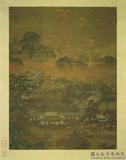清董誥繪高宗御筆甲午雪後即事成詠詩 軸
推薦分享
資源連結
連結到原始資料 (您即將開啟新視窗離開本站)後設資料
- 資料識別:
- 故畫002697N000000000
- 資料類型:
- 類型:繪畫
- 型式:靜態圖像
- 著作者:
- 董誥
- 主題與關鍵字:
- 冬景(雪景) 松 梅(白.紅.蠟梅) 亭 欄杆 傢俱(屏風) 年節 燈籠 如意 香爐.火盆 童玩 樂器 花器 飲食器 庭院 房舍 茶花 竹 孩童
- 出版者:
- 數位化執行單位:國立故宮博物院
- 日期:
- 清高宗乾隆三十九年(1774)
- 格式:
- 本幅 93.5x46.7公分、全幅 69公分
- 關聯:
- 石渠寶笈三編(延春閣),第五冊,頁2388-2389&*故宮書畫錄(卷八),第四冊,頁114&*故宮書畫圖錄,第十二冊,頁299-300&*董誥(西元一七四○-一八一八)浙江富陽人。字西京,號蔗林,董邦達之子。乾隆廿八年進士,官至大學士,值南書房。死後諡「文恭」。 乾隆三十九年(一七七四)臘月,高宗詠雪詩成,命董誥作画。本幅即繪冬雪庭園,屋中賓主對飲。屋後植松、竹、梅三友,群兒戲於庭中。庭前茶梅盛開,並置石榻,榻上水仙、靈芝、事事(柿)吉(桔)慶(磬),描繪出童叟歲朝歡慶之景。董氏不過份刻劃形象,頗有率真之趣,設色雅艷,饒有熱鬧之氣氛。 &* A native of Fu-yang Chekiang, Tung Kao (tzu His-ching; hao Che-lin) was the son of Tung Pa-ta. He received the chin-shih in 1764 and was subsequently appointed a scholar of the Southern Hall. He received the posthumous title Wen-kung. In 1774 A.D. the Ch’ien-lung Emperor completed a poem entitled Yung-hsüen and ordered Tung Kao to paint a scroll illustrating it. A palace courtyard is covered with snow. In the building a host and guest drink wine while a group of children play in the courtyard. Behind the building, pines, bamboo and plums have been planted and the plums have begun to bloom. Narcissus, moss, persimmons, an orange and a chime are placed on a stone bench. The joyous atmosphere created by the celebration of the New Year is admirably suggested. Here Tung’s style reveals itself as naïve rather than precisely realistic. The color is rich and elegant giving the painting a lively appearance. &*1.〈清董誥繪高宗御筆甲午雪後即事成詠詩〉,收入林莉娜編,《京華歲朝》(臺北:國立故宮博物院,2008年初版一刷),頁36。
- 管理權:
- 國立故宮博物院
授權聯絡窗口
- 國立故宮博物院圖像授權、出版授權、影音資料授權-申請流程說明
http://www.npm.gov.tw/zh-TW/Article.aspx?sNo=03003061






